Group ride with York Cycle Campaign – 23rd September 2019
Background
One of the cornerstones of the My Future York approach to public engagement has been “Look at your City” events where we’ve walked or cycled around parts of the city to reflect on how they work, and how we might learn lessons which can then be applied in making a better brief for new development. When the Castle car park is replaced by new public realm, and new routes are created to and through these spaces, we’ll need to carefully consider how to provide safe routes for movement along with vibrant public space which encourages carefree lingering; the two don’t always easily mix. The purpose of this ride – put together by Gavin Welch and fronted on the day by Kate Ravillious – was to ride through a carefully-chosen mix of routes and spaces where cyclists share space with pedestrians and (in some cases) motor vehicles. The group included able-bodied people and disabled people – crucially including those for whom getting around by cycle was much easier than getting around on foot – and also people who are disabled in ways which were not obvious to the casual observer.
Gavin provided a very helpful background document for the event which set out the signage, the nature of any restrictions on movement for the various places we’d visit, and also collision statistics.
The Ride
We set off from the station, across the new Scarborough Bridge, before skirting around Marygate car park and up Marygate into the evening traffic of Bootham. Crossing the Bootham/Gillygate junction we went along High Petergate to Duncombe Place, and onwards through Minster Yard and down Goodramgate to Parliament Street. From there we (partially) escaped the increasing rain in order to reflect on the ride and lessons learned.
I’ve set out a brief analysis below, based upon the main issues which were discussed, rather than the specific places they relate to, as this allows easier transfer of the issues to thinking around the design brief for Castle Gateway.
Key issues
- Making Disability Visible: People use cycling for mobility in response to a wide variety of disabilities. In some cases disability is obvious (use of recumbent trike, carrying crutches or sticks) while in others there are few or no outward signs. This means that response from pedestrians varies – trike users said that people were generally aware and accepting of them cycling amongst them, but for those riding bikes with balance issues (hence finding it problematic or impossible to ride at walking pace) there could be conflict – they had been told to get off and walk. This in turn led to different approach by the cyclists – a call for blue badge cycling by those who wanted their needs made visible, which was firmly rejected by those whose disability was already clear.
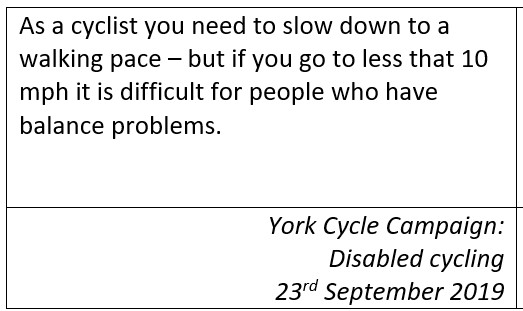 |
 |
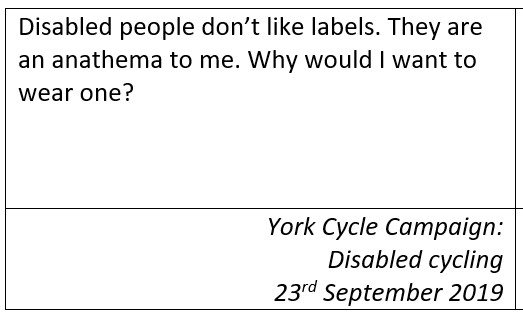 |
- Making Cycle Routes Accessible: Some routes which had been designed for cycle use (sharing space with pedestrians) didn’t work well due to their physical properties – too narrow, too steep, too bendy. These routes *may* have been okay for able-bodied cyclists but certainly didn’t work well for disabled people using cycles for mobility. As was pointed out, where routes don’t work for disabled cyclists, they will either resort to car use with a blue badge for parking, or simply be unable to make use of the city centre.
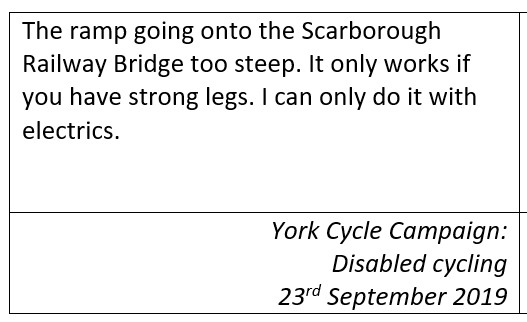 |
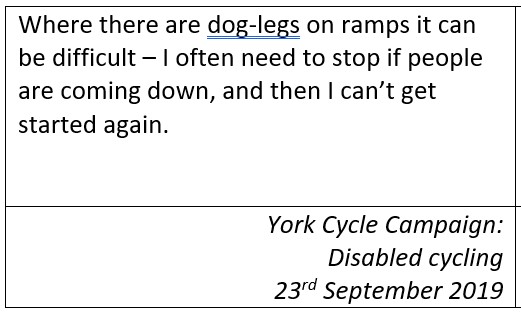 |
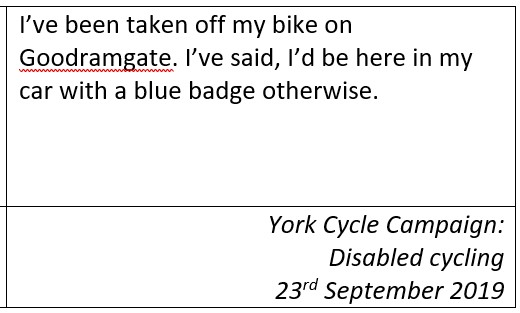 |
- Cyclist Behaviour: There was uncertainty about aspects of cyclist behaviour – what does it mean when a cyclist rings their bell? It may simply mean “I’m here” but is seen as rude or impatient by some pedestrians. There are issues too about behaviour of some cyclists – couriers often travel very fast near pedestrians. There may be very few collisions, but what does this do to perception of cyclists in urban spaces? And if there is always an element of conflict, does removing vehicles from the mix at least make the consequences less severe?
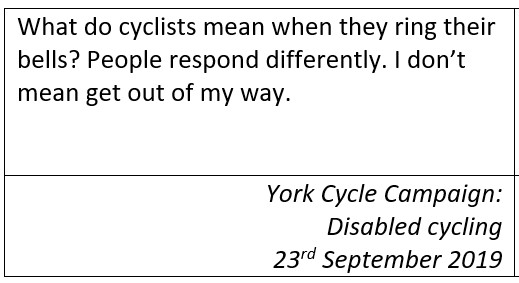 |
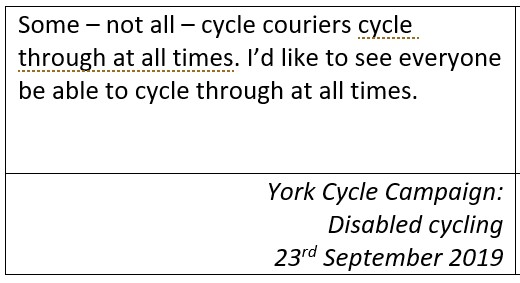 |
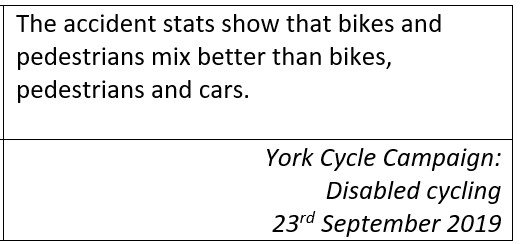 |
- Communicating Cycle Routes: Lastly, indicating routes which are dedicated/priority cycle routes needs thought. Signage seems to work best where people are looking – at paving level rather than elevated on poles – and use of colour can be effective. But this brings maintenance issues and use of tactile features such as kerbs can be very mixed in its impact where spaces are informal and people aren’t necessarily paying attention.
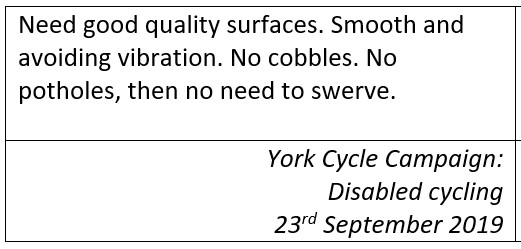 |
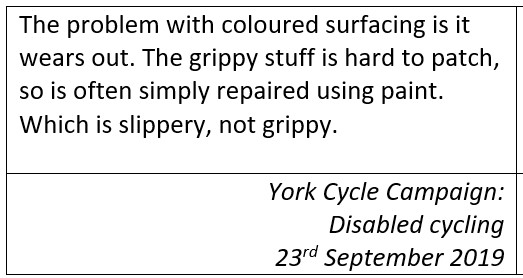 |
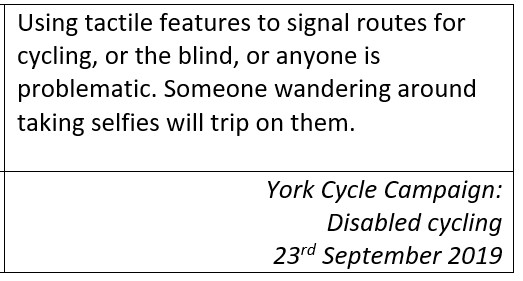 |
In conclusion, two points stood out as challenges.
When conflict can’t be designed out: The first was that enabling really effective access for cyclists – and especially for people using cycles as a mobility aid – would probably result in some conflict due to greater mixing of cycles with other users of public space on foot. It may not be possible to design this out and some adjustment of expectations and behaviour might be needed (although evidence from Amsterdam suggests even there that conflict can’t be eliminated).
Reducing conflict through redistributing space: However, the second point is that more space for movement makes conflict less likely. Where more space needs providing on streets shared with vehicular traffic, in many cases this will only be possible where space is taken away from other road users.
All of the comments and summaries of discussions recorded on the ride can be viewed on the My Castle Gateway Flickr site here.
Wheels for Wellbeing has launched a “My Cycle, My Mobility Aid” campaign which aims to improve understanding amongst the public, policymakers and police of the fact that most Disabled cyclists use their cycle as a mobility aid, but are often penalised for doing so. Wheels for Wellbeing are at www.wheelsforwellbeing.org.uk and information about the campaign can be found here.